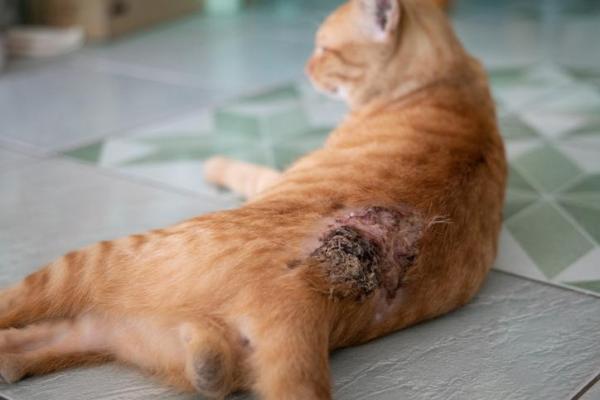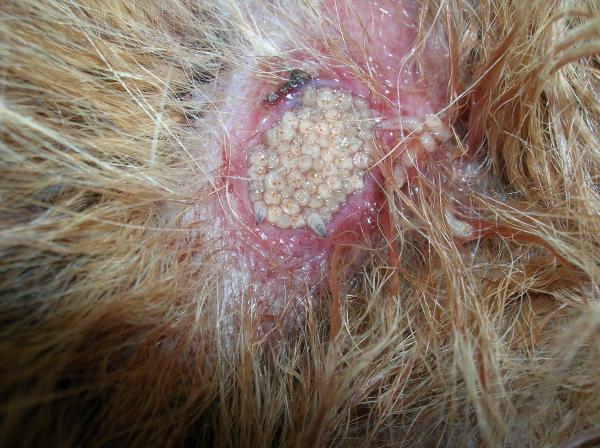My Cat Has Maggots in Their Wound



See files for Cats
We all may be aware that worms in cats are a fairly common type of parasite. Unfortunately, internal worms do not always show symptoms, especially during early stages of the infestation. We may not notice until we see white spots in their feces. However, not all worms are the same. A more obvious symptom and one of the most disturbing health problems we may see in a cat are maggots in their skin. This is caused by a particularly nasty parasite which starts as a fly leaving larvae in the skin. The resultant condition is known as myiasis.
At AnimalWised, we take a look what happens when your cat has maggots in their wound. We explain the nature of this disease, what the prognosis may be like for your feline and how we can best prevent myiasis in cats from occurring in the first place.
What is myiasis in cats?
Diptera is an order of insects which encompass true flies. It is a very large group with over 1,000,000 estimated species. Their life cycle involves larvae which develop into pupae and then the adult fly. The larave are referred to as maggots, worm-like creatures which metamorphosize into the winged insects we recognize as flies.
Myiasis occurs when the flies lay eggs in a host, in this case a cat. In most cases, for the larvae to survive they need to feed off the host. There are three main types of myiasis causing parasites:
- Obligate parasites: these types of parasite require living tissue for their larvae to survive.
- Facultative parasites: living tissue can act as a means for their larave to develop, but they can also survive in decomposing animal tissue or plant matter. This means they can be either free living or parasitic[1].
- Accidental parasites: these parasites do not need to live in a host to survive and do not look for living or dead tissue. They enter the body by accident, usually through ingestion or entering a wound site.
Pseudomyiasis occurs when the larvae do not actually enter the tissue of the animal and are passed through the feces[2]. This can be seen when there are white worms (maggots) in the cat's stool. It may cause symptoms, but not as acute as true myiasis.
Not all fly species will be parasitical in cats or other animals. Those that do pose the risk of myiasis. One of the most common type of obligate parasite fly which infests animals is from the genus Cuterebra, also known as rodent bot flies. For facultatiive myiasis, the most common come from the Calliphoridae family of insects[3]. These are commonly known as blow-flies or bluebottles.
Infestation usually occurs in warm and humid areas as these provide the best conditions for the larvae to develop. Although cats are generally very hygienic animals, these insects will be particularly attracted to dirty sites. This is why cats with skin folds, knots or tangles of long hair are more likely to be affected.
However, the most common sites of seeing maggots in our cat caused by myiasis are wounds. This is because they may enter through damaged tissue, meaning a cat which already has a wound might attract the fly. This is why we may see maggots in your cat's wound, since this is the site they have infested. Wounds are not the only place these maggots may be seen. You can also see them in the insides of ears or the navel of newborn kittens. This is why cats with access to the outside or with a poor state of health are more likely to be affected.
Symptoms of myiasis in cats
If you are wondering whether your cat has myiasis, it is likely you have seen its most obvious symptom. The larvae of the flies are very small when they enter the cat's flesh, but as they feed of the tissue, they grow. They do so by secreting enzymes capable of breaking down the skin and tissue. The result are wounds which appear as round holes.
Before the skin is broken, it may be possible to see movement of the larvae underneath it. The larvae leave their eggs 3 days after they are laid in the tissue. They usually develop for about two weeks. Surprisingly, there aren't many other symptoms which affect the cat. It is possible for the cat to be infested, but otherwise be fine. However, if there are enough maggots present in the skin, the enzymes and toxins they produce can cause shock.
A large number of maggots can also destroy enough tissue to threaten the cat's life. This may also depend on the species of parasite, since large larvae cause more damage. Another complication is if the wound sites become infected with bacteria. For all of these reasons, it is very important you take the cat to a veterinarian if you see maggots in their wounds.

How to treat myiasis in cats and remove the maggots
As we stated above, it is vital you take the cat or kitten to a veterinarian. Even though the presence of maggots means infestation is likely, we need to have a professional diagnose the problem. They will not only inspect the wound you have seen, but look for any other possible sites of infestation as it is possible they are all over the cat's body. Once they are located, the maggots will have to be manually extracted from the skin of the cat.
Another aspect of treatment is cleaning the wound site. The necrotic tissue will need to be sterilized and the hair from around the area removed. This will help to avoid the infestation returning as well as lessening the chances of bacterial infestation. Treatment of myiasis in cats can be very uncomfortable for the cat. Some may have to be restrained or sedated, another reason going to a veterinary professional is essential.
After the first interventions are carried out at the clinic, the veterinarian will explain how to heal the wounds at home. They will have to be regularly disinfected. It is also likely the veterinarian will prescribe some sort of treatment to combat any larvae which may still remain in the cat's tissue. These anti-parasitic medications may be in topical or injection form. Rarely will tablets be used unless they are required to compact an accompanying bacterial infection caused by the myiasis. We should never medicate the cat ourselves without direction from the veterinarian.
How are maggots extract from a cat's wound?
It will be possible for us to remove the maggots ourselves from the cat's skin, but for many reasons it is inadvisable. There are videos on YouTube of worms being removes from a cat's flesh. If you watch them, you will see some people remove them by hand. While this may be possible with experienced clinicians, it is better to use specialized tweezers.
A veterinarian will ensure all utensils are properly sterilized and will perform it in a sterile clinic. Similarly, the cat themselves will need to be disinfected. Anaesthesia may also be required to prevent them moving and causing further harm.
Are there home remedies for myiasis in cats?
Myiasis is not a disease that can be treated at home. Although we can see the larvae and even be able to remove some of them ourselves, many others may remain hidden inside the body. They can cause serious damage and lead to new wounds forming in the cat's tissue. Additionally, serious infestations can lead to toxic shock and death.
When there are enough larvae present, the cat may need to be admitted to a veterinary hospital to stabilize their condition. Another reason there are no home remedies for myiasis in cats is that products we have in the home are not sufficient. Anti-parasitics and antibiotics which are used to treat this condition need to be medical grade to work properly. Insect repellents which can be bought in shops are either not substantial enough or harmful if used incorrectly.
The treatment we perform at home is that which is detailed to us by the veterinarian. It will require us to ensure their wounds are tended to and further infection/infestation is not acquired.

Is it possible to prevent myiasis in cats?
Myiasis can be best avoided by preventing them access to the outside. This is especially so during the periods of the year when flies, mosquitos and horseflies are most proliferated. This may not always be applicable depending on the individual cat. However, we can be particularly careful when the cat is older, sick or injured. When a cat has an open wound, avoiding access to the outside is a better way to protect them.
With cats which are able to be kept outside, we need to provide the correct prevention treatment. The type of deworming product should be suggested by your veterinarian. The cat should have their vaccinations to best prevent from many diseases, but they will not prevent myiasis. Since the flies are particularly attracted to dirty cats, hygiene is an important aspect of myiasis prevention.

This article is purely informative. AnimalWised does not have the authority to prescribe any veterinary treatment or create a diagnosis. We invite you to take your pet to the veterinarian if they are suffering from any condition or pain.
If you want to read similar articles to My Cat Has Maggots in Their Wound, we recommend you visit our Parasitic diseases category.
1. Luong, L. T., & Mathot, K. J. (2019). Facultative Parasites as Evolutionary Stepping-Stones Towards Parasitic Lifestyles. Biology Letters, 15(4), 20190058.
https://doi.org/10.1098/rsbl.2019.0058
2. Hendrix, C. M. (n.d.) Pseudomyiasis. Retrieved on February 6th, 2020, from
https://www.msdvetmanual.com/integumentary-system/flies/pseudomyiasis
3. Pezzi, M, et al. (2019). Myiasis in Domestic Cats: a Global Review. Parasites and Vectors, 12(372).
https://doi.org/10.1186/s13071-019-3618-1
- Bars, Juan. Myiasis Veterinary Clinical Dermatology.







